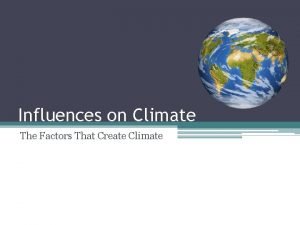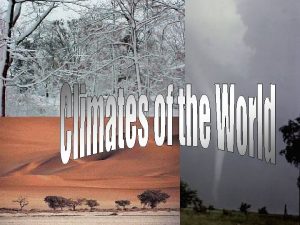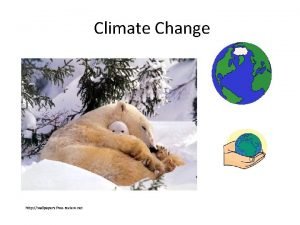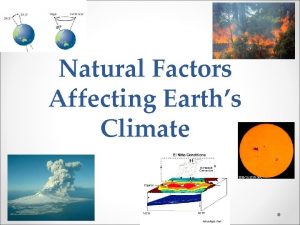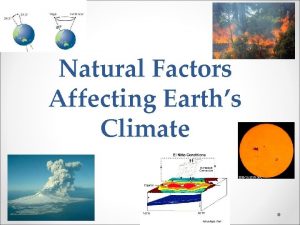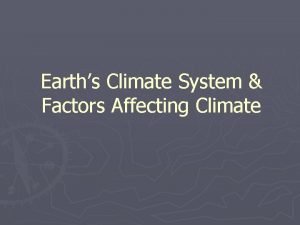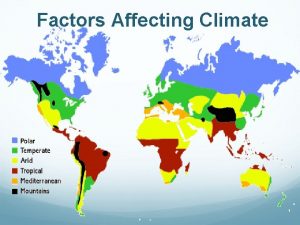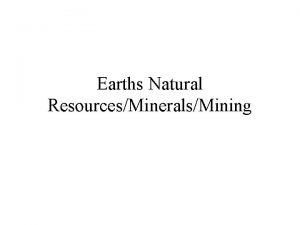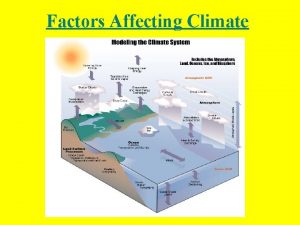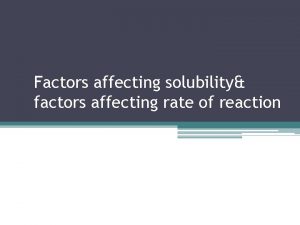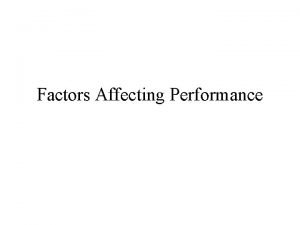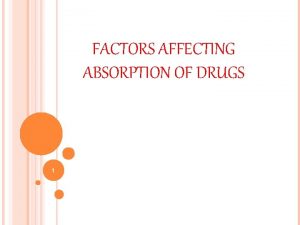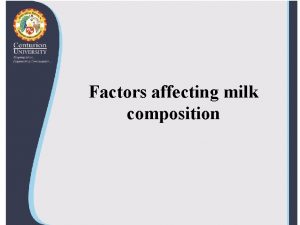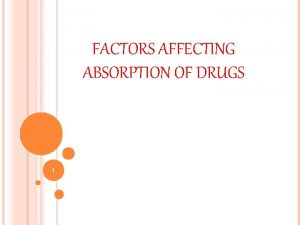Natural Factors Affecting Earths Climate Natural Events Affecting
















- Slides: 16

Natural Factors Affecting Earth’s Climate

Natural Events Affecting Climate Earth’s climate is complex • There a number of factors that have affected our climate in the past and continue to do so today • These are called Climate Forcings • These include: o Milanokovitch Cycles o Sun Spots and Solar Flares o Plate Tectonics o Major Volcanic Eruptions o El Nino and La Nina o Forest Fires

Milankovitch Cycles • Named after a Serbain mathematician, Milutin Milankovitch • EXTREMELY long term for effects that scientists think may be the cause of the ice ages. • These are movements of the Earth that affect the amount of solar radiation that it gets.

Milankovitch Cycles Earth’s wobble, tilt, and orbit Precession Obliquity Eccentricity

Milankovitch Cycles Precession Direction of the Earth’s axis changes over time The Earth wobbles like a top on its axis 26, 000 year cycle

Milankovitch Cycles Obliquity The tilt angle of the Earth’s axis changes over time The greater the tilt the greater the differences in the seasons. 40, 000 year cycle

Milankovitch Cycles Eccentricity Varying shape of Earth’s orbit, e. g. how elliptical it is 100, 000 year long cycle Animation

Solar Cycles Sunspots are storms on the surface of the sun and are associated with extremely strong magnetic activity, solar flares hot gaseous emissions These follow an 11 year cycle. Scientific research estimates that normal fluctuations due to Solar Cycles increase or decrease solar radiation reaching Earth by only 0. 1% - 0. 2%.

Plate Tectonics and associated Continental drift • Have been exerting their effect on the Earth’s geography over billions of years • Have shaped the continents as we know them • The impact on climate (very long term, and in the past) was: o by changing land mass and ice caps (size & location) and o changing ocean circulation patterns which transport heat around the Earth and in turn o influences atmospheric circulation processes.

Volcanic Eruptions Volcanic eruptions of ash and gases into the troposphere and above cause SHORT TERM cooling (few years). The gases released are mainly water (H 2 O), carbon dioxide (CO 2) and sulfur dioxide (SO 2). The 1 st 2 do not change ambient levels by much. But the SO 2 reacts with H 2 O to form sulfates. Sulfates increase the brightness (albedo) of clouds, reducing the solar radiation reaching Earth. The large volumes of ash also block some incoming solar radiation but the effect is less significant and more short lived.

Volcanic Eruptions Do Volcanic eruptions cause long term climate change? Apparently not. There is evidence of slight warming at some times, and slight cooling at other times. In these cases any temperature changes are minimal and short lived. Interesting point: During the time before and at the beginning of the Little Ice Age, there was an increased incidence of volcanic activity – enhancing the effect of the Sun Spot minimum.

El Niño/La Niña El Niño is a large scale change in oceanic and atmospheric circulation in the eastern equatorial Pacific and involves rapid, large scale warming of the sea-surface. Peruvian fishermen have noticed this because the warming is linked to a stop in the upwelling of deep nutrient-rich cold water just off their coast. During an El Niño event, this lack of nutrients reduces the productivity of the ocean and fish populations decline dramatically. La Niña is the opposite, a rapid cooling in this area.

El Niño/La Niña Transition between El Niño and La Niña O Observe the demo of El Niño (which will oscillate into La Niña). Observe it carefully & record 3 observations about what happens. (Check yourself – they should all be based on information you got from your senses. ) http: //www. pmel. noaa. gov/tao/jsdisplay/plots/gifani/sst-wind-cureqt-20 c. gif

El Niño/La Niña Impacts: • Tradewinds are weaker than average • Causing pools of warm water to move eastward across the ocean towards South America o The cold upwelling water is reduced, the water warms (and levels rise) causing the fish to move away o Warm waters produce lower air pressures, which increase convection, and increase rainfall – which can cause flooding. • In tropical western Pacific (e. g. New Zealand) there is a slight decrease in ocean levels, lower convection and drought conditions

El Niño/La Niña El Niño and La Niña impact Canadian weather too! The La Niña that has been present since 2010 ended in April 2012. Scientists are predicting that El Niño conditions will likely start to develop this autumn. Use the map on the next page (from Environment Canada’s Project Atmosphere) to PREDICT OUR WINTER PRECIPITATION

Forest Fires Forest fires produce a lot of smoke – made up of particulates and gases. Based on what you learned about volcanic activity, what impact could large forest fires have on climate? -will this impact be local? Global?
 What are the factors affecting the climate
What are the factors affecting the climate What are the factors affecting the climate
What are the factors affecting the climate Factors affecting climate
Factors affecting climate Lesson 2 factors affecting climate answers
Lesson 2 factors affecting climate answers Factors affecting global warming
Factors affecting global warming Climate change 2014 mitigation of climate change
Climate change 2014 mitigation of climate change How is climate change our health
How is climate change our health Mutually exclusive vs non mutually exclusive
Mutually exclusive vs non mutually exclusive Earth layers foldable
Earth layers foldable Earths roation
Earths roation Whats a natural satellite
Whats a natural satellite Forest desert tundra grassland
Forest desert tundra grassland Pnitogens
Pnitogens How thick is the earths crust
How thick is the earths crust Whats earths moon called
Whats earths moon called Earth's thickest layer
Earth's thickest layer Earths early atmosphere contained
Earths early atmosphere contained

